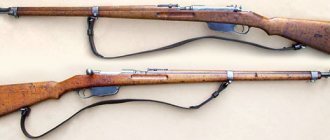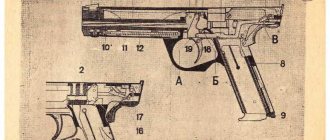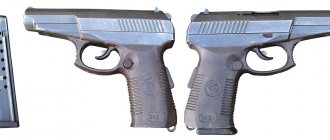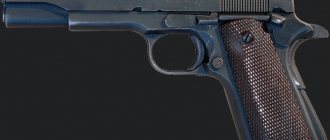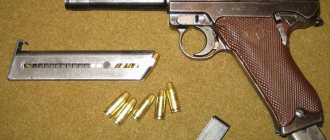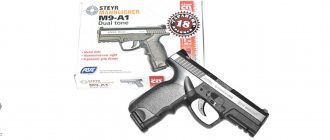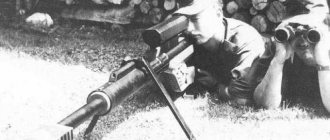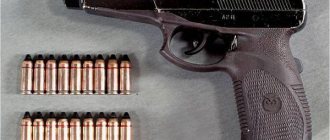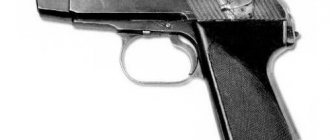"Steyr M1912" redirects here. For the rifle, see Steyr Model 1912 Mauser.
| This article includes a list of common references, but it remains largely unverified because It lacks a sufficient number of relevant embedded links . |
Semi-automatic pistol, Submachine gun (Repetierpistole M1912/P16)
| Steyr M1912 | |
| Steyr M1912 with box and magazine clip for Steyr 9×23mm ammunition | |
| Type | Semi-automatic pistol, Submachine gun (Repetierpistole M1912/P16) |
| Place of origin | Austria-Hungary |
| Service history | |
| Used |
|
| Wars |
|
| Production history | |
| Manufacturer | Œ.WG |
| Produced | 1912–1945 |
| No built | Up to 300,000 |
| Options |
|
| Characteristics | |
| Weight | 1.2 kg (2.6 lb) |
| Length | 216 mm (8.5 in) |
| Barrel length | 128 mm (5.0 in) |
| Cartridge |
|
| Action | With dedication |
| starting speed | 1,230 ft/s (375 m/s) [note 1] |
| Effective firing range | 50 m (160 ft) |
| Feeding system | Built-in 8-round magazine fed by puller clips |
| Attractions | Iron sights |
| Recommendations | Jane [1] |
Steyr-Khan M1912.
Manufactured in 1915 chambered in 9x23 Steyr with holster and ammunition. Steyr M1912
, also known as
the Steyr-Hahn
, is a semi-automatic pistol developed in 1911 by the Austrian firm Steyr Mannlicher, based on the Roth-Steyr M1907 action. It was developed for the Austro-Hungarian army and entered service in 1912. It was a standard WWI Austro-Hungarian military pistol.[2][3] It was able to withstand the harsh conditions of trench warfare during the First World War.
The M1912 was originally chambered for the 9mm Steyr cartridge.
History[edit]
M1912
was designed as the Model 1911 military pistol, but it did not enter service until 1914 as the M12.
It was initially issued to the Austrian Landwehr, while the Roth–Steyr M1907 pistols and Rast & Gasser M1898 revolvers were issued to rank and file army units. Chile and Romania have also placed orders. During World War I, Austria-Hungary experienced a pistol shortage and production of the M1912 was increased. Germany also placed an order for 10,000 Model 12s. After World War I, a commercial Steyr M1911
was produced and was quite popular among army officers, but Steyr had to rely on foreign exports to maintain production. After Germany annexed Austria in 1938, the Wehrmacht ordered 60,000 M1912 pistols converted to 9mm Parabellum, which remained in service until the end of World War II.
Pistol Steyr M1911 / Steyr M1912 / Repetierpistole M12
| Steyr M1911 commercial model |
In 1911, Austrian gun designer Karel Krnka created a new self-loading pistol called the Steyr M1911, which also became known as the Steyr-Hahn (“hahn” is from the German “trigger”). At the same time, its production was established at the Österreichische Waffenfabrik Steyr arms factory (Austria).
adjustable rear sight and commercial model stamp Steyr M1911
The Steyr M1911 pistol was developed for military use and was one of the first combat pistols to use a powerful cartridge with high penetration and stopping power of the bullet. A powerful cartridge 9 mm Steyr (9x23 mm) was developed for it with a shell bullet weighing 7.5 g, which developed an initial speed of up to 385 m/s.
However, the Austro-Hungarian army did not pay due attention to the new pistol, since its regular units by this time were equipped with Roth-Steyr M1907 pistols and Rast-Gasser M1898 revolvers, and the Hungarians planned to arm their rear services and reserve units with the Frommer Stop pistol.
Then the Steyr M1911 pistol was offered for the civilian weapons market. The commercial model Steyr M1911 may have an adjustable rear sight and the stamp "OESTERR.WAFFENFABRIK STEYR M.1911 9m/m" on the left side of the bolt housing.
| Steyr M1911 adopted by the Chilean Army |
Steyr M1911 partial disassembly
It is believed that a commercial version of the Steyr M1911 pistol was purchased in small quantities by officers of the Austro-Hungarian army, but the Österreichische Waffenfabrik did not rely mainly on them, but on large export contracts, under which a significant number of pistols were sold to 1912 in Chile, and in 1913 - in Romania. Income from these operations allowed Steyr to support the production of the M1911.
Models of Steyr M1911 pistols adopted by the Chilean Army can be distinguished by the coat of arms of the Republic of Chile in front of the inscription STEYR 1912 and MOD. 1911 on the left side of the bolt housing and the stamp "EJERCITO DE CHILE" (Chilean Armed Forces) on the right side. In total, about 5,000 of these pistols were produced.
Romania, according to various sources, purchased from 25 to 56 thousand Steyr M1911 pistols. Such pistols have a mark in the form of a crown in the front part of the left side of the bolt casing with the designation Md.1912 below it.
| Steyr M1911 export version for Romania |
According to some sources, the Steyr M1911 pistol was adopted by the reserve units of the Austro-Hungarian army in 1912 under the name Repetierpistole M12 (according to other sources - “9 mm Selbstiade Pistole M.12”).
When the First World War began, the army of Austria-Hungary, as one might expect, began to experience an acute shortage of personal short-barreled weapons. As a result, the Steyr pistol was officially adopted by Austria-Hungary as a personal short-barreled weapon, later becoming known as the Steyr M1912. On the back of the left side of the bolt-casing, pistols adopted by the Austro-Hungarian Armed Forces were marked “STEYR1912”, which could also contain another year, depending on the year of manufacture.
| Steyr M1912 manufactured in 1918 |
In 1916, 10,000 Steyr M1912 pistols were ordered by the Bavarian Army. A similar order was made in 1918 - apparently, in this way the warring German units tried to compensate for the acute shortage of “parabellums”. This weapon is distinguished by the presence of Prussian military marks on the front of the trigger guard or the left side of the frame, behind the trigger.
Steyr M1912 top view
Operating experience of the Steyr M1912 has shown high operational reliability, long service life and excellent shooting accuracy of the pistol, especially during the First World War, in difficult operating conditions, such as heavily contaminated mechanisms and prolonged lack of cleaning. In the production of the pistol, high-quality weapon steel with a blued coating was used. In addition, the pistol has proven itself to be an excellent melee weapon due to its effective, powerful 9 mm cartridge. Its bullets easily penetrated thick tree branches, dense bushes and various elements of uniform, after which they had a fairly high stopping and penetrating effect. Unlike lightweight, compact 7.65 mm pistols such as the Browning Models 1900 and 1910, which were often preferred by many armies for ease of carry, or older revolvers up to 8 mm in caliber, Steyr bullets were effective at killing the enemy. However, the large length and kilogram weight, which were among the disadvantages of this generally wonderful pistol, soon made themselves felt with the beginning of the trench period of the war. Many commanders wanted a weapon that was less burdensome to carry all the time, and as a result, after the war, work began in Hungary on a compact pistol for the armed forces.
| Caliber, mm | 9x23 (9 mm Steyr) 9x19 (9 mm Parabellum) |
| Length, mm | 216 |
| Barrel length, mm | 128 |
| Weight without cartridges, kg | 1.200 |
| Store, count. cartridges | 8 |
| Initial bullet speed, m/s | 385 (9 mm Steyr) |
| Effective firing range, m | 50 |
With the collapse of the Austro-Hungarian Empire, production of the Steyr M1912 ceased in 1918. It is believed that approximately 250,000 Steyr Model 1912 pistols were produced.
After the First World War, these pistols were in service with the armies of Poland, Hungary, Austria, Romania, Yugoslavia and Chile.
In 1918, Italy, as one of the victorious countries in the war, received several thousand Steyr M1912 pistols, which it inherited from the Austro-Hungarian army. A few years later they were already brandished by the Blackshirts who organized the march on Rome in 1922, and during the Second World War they were used by Italian partisans. This pistol was never adopted by the Italian army, except for small batches that were sent to the colonial troops.
The Austrian army retained the Steyr M1912 pistol in service until 1938, until it joined the Third Reich.
Following the German annexation of Austria in 1938, approximately 60,000 pistols were chambered to fire the standard German 9 mm Parabellum (9x19 mm) cartridge. In the Wehrmacht, such pistols were designated Pistole 12(Ö). They can be identified by their "08" and Nazi eagles. During the Second World War, these pistols were used by the German police and various occupation units.
| Pistole 12(Ö) P12 chambered for 9 mm Parabellum (9x19 mm) |
During the Second World War, Steyr pistols of the 1912 model, in addition to the Wehrmacht, were in service with the armies of Hungary and Romania.
The career of the Steyr M1912 pistol can be considered over in 1945 with the defeat of Nazi Germany.
After the end of World War II, none of the armies in the world used this pistol as a standard weapon anymore. Steyr M1912 barrel: 1 - lugs;
2 - turning protrusion; 3 - limiting protrusion The automation of the Steyr M1912 pistol works on the principle of recoil of the barrel with its short stroke. The barrel bore is locked by rotating the barrel around its axis.
The inside of the barrel has a rifled bore with six grooves curling from left to top to right, a chamber with a bevel at the bottom of the breech to guide the movement of the cartridge from the magazine, and a cutout for the ejector tooth.
From the outside, the barrel has a cylindrical shape with four protrusions: two lugs have a helical shape with bevels on the front wall; turning ledge; limiting protrusion. Shutter housing Steyr M1912: 1 - recess;
2 - protrusion The casing-bolt is a part that connects the casing and bolt into one; it has: two grooves with beveled helical walls to accommodate the barrel lugs; two pairs of guide protrusions; eyes for attaching checks; outlet window with a ledge for installing a clip; ejector socket; firing pin socket with spring; cup for the bottom of the sleeve; a recess for installing the bolt casing in the rear position while loading the pistol; a protrusion for blocking the bolt casing when the pistol is put on safety.
The pistol frame is integral with the handle and trigger guard and contains: groove-shaped guides for placing the barrel; grooves for movement of the shutter casing; socket for mounting a cartridge delay; through longitudinal groove for pin movement; trigger slot; magazine box in the handle; windows on the base of the handle to facilitate disassembly and assembly of the pistol; holes for the hammer and trigger axes; screw and annular grooves for the screw and limiting protrusions of the barrel.
Parts of the Steyr M1912 pistol: 1 — casing-bolt;
2 — front sight; 3 — connecting pin; 4 - ejector; 5 - drummer; 6 — hammer spring; 7 - trunk; 8 - frame; 9 - disconnector; 10 - trigger; 11 — trigger rod; 12 — trigger; 13 - delay; 14 — delay spring; 15 - fuse; 16 — bottom of the magazine box; 17 — disconnector spring; 18 — trigger spring; 19- mainspring; 20- return spring; 21 — return spring stop; 22 — return spring button; 23 — feeder; 24 — feeder spring; 25 — cheekpiece At the bottom of the handle there is a swivel for attaching a pistol belt. The wooden cheeks of the handle have a diamond-shaped notch with a smooth border around the edges.
The return mechanism consists of a return spring, a stop and a button. The return spring is twisted cylindrical. A button is a short cylindrical rod with a flat head with projections into which the coils of the return spring rest.
The supply of cartridges to the chamber is ensured by the magazine, the bolt and the cartridge delay. The magazine is permanent and is located in the pistol grip. The magazine consists of a box, a feeder, a feeder spring and a magazine bottom. The magazine box is the front part of the internal channel of the handle, fenced off by a jumper. The feeder has a box-like shape with windows on the sides. The side ribs serve as guides. At the bottom of the feeder there is a protrusion for securing the spring. The feeder spring is twisted and rectangular in shape. The bottom of the magazine is a complex part that has an eyelet the length of the bottom for a belt; a high stand located at an angle with a recess in the lower part for fixing the combat spring, trigger spring and disconnector; a protrusion in the shape of the base of the feeder spring for fixing the spring; holes for fixing the bottom in the pistol handle. The cartridge delay contains a long branch with a closed end for limiting the upper cartridge, grooves for guiding in the frame, a comb, a protrusion for acting on the feeder, and a heel for supporting the spring.
The barrel bore is locked using the rotating, limiting and combat protrusions of the barrel, helical grooves of the bolt casing, screw and annular grooves of the frame when the barrel is rotated around its axis.
The trigger mechanism is hammer type with an open trigger, single action. The fuse is mechanical.
The trigger mechanism consists of: a hammer with a spring; trigger; mainspring; trigger; disconnector with spring; trigger pull; trigger spring. The hammer is a cylindrical rod of two different diameters. The rod of smaller diameter has a firing pin at the end, the rod of larger diameter has a recess for the ejector ledge and a head for contact with the trigger. The striker spring is twisted cylindrical. The trigger includes a head, a combat cock, a protrusion for resting the mainspring, a ledge for interacting with the fuse, two sockets for placing parts of the fuse, and a hole for the axle.
The mainspring is plate-type, having a slightly curved end with a curved platform for contact with the trigger. The trigger has a tail and a head with a hole for the trigger axis and a head with a slot for connection with the trigger rod. The disconnector, in addition to its main function - to disengage the trigger from the sear - also serves as a reflector of spent cartridges and a fuse against premature firing. It has a reflector tooth, a head for interaction with the bolt recess, a beveled heel for the spring stop, two side protrusions forming a groove for placing the trigger rod, and guide side edges. The disconnector spring is a plate with a slight bend. The trigger rod is a flat, narrow part that has two spikes: the front cylindrical spike is for connecting to the trigger head, the rear spike is for connecting to the trigger spring. The trigger spring is a plate with a hook-shaped bend at the end. It has a tooth that acts as a sear.
The mechanism for removing spent cartridges consists of an ejector and a reflector (the role of the reflector is performed by a disconnector). The ejector is a part that has a split spring arm with a heel and a tooth at the front and a ledge with a hole for the pin, which fits into the recess of the striker and limits its movement.
The role of a fuse against accidental shots is performed by a flag fuse, which has a flag with a recess in the middle for locking the bolt casing and a comb; split springy rod with a recess in the middle. The safety can be activated in any position of the trigger. The role of a fuse against a premature shot is performed by a disconnector.
Sighting devices consist of a movable front sight fixed in the ledge of the front part of the bolt casing, and a permanent rear sight in the form of a stand with a slot on the back of the bolt casing.
Operation of parts and mechanisms of the Steyr M1912 pistol: Initial position. The barrel and the bolt casing, connected to each other, are in the forward position under the action of the return spring. The barrel lugs are in the grooves of the bolt casing, the turning protrusion is in a helical groove, and the limiting protrusion is in the semi-circular groove of the frame. The return spring is in the state of least compression. A flat connecting pin is inserted into the eyes of the bolt casing, which passes through the through window in the frame and through the through cutout of the return spring stop. The trigger, under the action of the mainspring, is in the upper position and presses on the firing pin. The trigger spring is at its lowest preload. The firing pin, under the action of its spring, takes the forward position, and its firing pin extends beyond the mirror of the bolt cup. The trigger spring is compressed and pressed against the trigger with its sear. The disconnector, under the action of its spring, occupies the upper position and its head enters the recess of the bolt, and the reflector enters the longitudinal groove of the bolt. The disconnector spring is at its lowest preload. The trigger rod lies in the groove of the disconnector; with its rods it contacts the trigger spring and the trigger. The trigger, under the action of the trigger rod and the trigger spring, takes the forward position and is pressed against the return spring button with the protrusion of the head. The feeder, under the action of its spring, is located at the top and is pressed against the bottom of the bolt. The fuse is off.
| Steyr M1912 while loading |
In order to load the pistol, you must: remove the pistol from the safety catch by turning the safety catch down; remove the bolt casing and lock it with the fuse by inserting the protrusion of the fuse into the front recess of the bolt casing; insert the clip into the grooves of the bolt casing and insert cartridges into the magazine; remove the clip; turn off the fuse and release the bolt casing. When the bolt casing is pulled back, the coupled barrel also moves with it.
The position of the parts of the Steyr M1912 pistol before loading: 1 - barrel (a - locking lugs, b - screw lug, c - combat lug);
2 — casing-bolt (d — guides for the magazine; d — rear sight); 3 - ejector; 4 - drummer; 5 - trigger; b - fuse; 7- disconnector; 8 — mainspring; 9 — trigger spring; 10 — disconnector spring; 11 — bottom of the magazine box; 12 — feeder spring; 13 - frame; 14 — feeder; 15 — trigger; 16 — return spring button; 17 — return spring; 18 - connecting pin: 19 - stop As the barrel begins to move backwards together with the bolt casing, the turning protrusion of the barrel, interacting with the walls of the frame groove, turns the barrel by approximately 60°, and the lugs of the barrel disengage with the bolt casing. The bolt casing and the barrel are disengaged, and then the bolt casing moves independently. When moving backwards, the bolt casing compresses the return spring, turns and retracts the trigger, retracting the disconnector. The trigger, turning, compresses the mainspring. The trigger spring sear slides along the lower end of the hammer, jumps behind the cocking of the hammer and keeps it cocked. The firing pin moves back under the action of its spring, and the firing pin extends beyond the boundaries of the bolt. The disconnector, when recessed by the upper side protrusion, turns the trigger rod. The trigger rod, lowering, disengages the rear protrusion from engagement with the trigger spring. The trigger spring, after lowering the rear protrusion of the trigger rod, takes its original position, in which its sear holds the trigger cocked, and the bent end rises above the rear spike of the lowered trigger rod. When cartridges are inserted into the magazine, they pass through the cartridge delay and recess it. After all the cartridges have advanced, the cartridge delay becomes above the top one and holds all the others in the magazine, and the top cartridge is located in the path of the bolt movement. After removing the clip and removing the pistol from the safety catch, the housing-bolt moves forward under the action of the return spring, removes the cartridge from the magazine and sends it into the chamber. The ejector with its tooth jumps over the edge of the sleeve and enters its annular groove. The rotating protrusion of the barrel, interacting with the walls of the frame groove, rotates the barrel until the limiting protrusion rests against the front wall of the frame groove (approximately 60°), then the lugs of the barrel enter the grooves of the casing-bolt, and the barrel and bolt fully engage shutter casing. The gun is loaded. The hammer is cocked. If there is no need to shoot, then the pistol is put on safety by turning the safety lever up. When the flag is turned, the fuse falls into one of the trigger sockets and blocks it, and the protrusion of the fuse enters the rear recess of the bolt housing wall and blocks it.
In order to fire a shot, you must remove the pistol from the safety catch and pull the trigger. The pistol is removed from the safety by turning the flag down. When you press the trigger, it turns, the head presses the return spring and pulls the trigger rod forward. The trigger rod, moving, retracts the end of the trigger spring with the protrusion of the sear. The sear releases the trigger. The trigger, under the action of the mainspring, strikes the firing pin. The striker breaks the primer with the striker. A shot occurs. The shutter casing moves back under the action of powder gases. Further operation of the parts and mechanisms is the same as when manually loading a pistol, with the exception that the ejector removes the cartridge case from the chamber and holds it until it hits the disconnector-reflector. After the impact, the cartridge case flies out the window. In order to fire the next shot, you must release the trigger and press it again. The trigger, after removing the pressure under the action of the return spring, turns its tail forward, and the head pulls the trigger rod back. The trigger rod, moving backwards, will rest against the trigger spring. The disconnector, under the action of its spring, raises the trigger rod until its rear spike stops at the bent end of the trigger spring. When all the cartridges in the magazine are used up, the feeder, under the action of its spring, rises and holds the bolt in the rear position. You can release the bolt casing by inserting the cartridge delay by the comb.
In order to unload the pistol, you must: move the bolt housing back and put the safety on; press the cartridge delay comb and remove all cartridges from the magazine; press the cartridge delay ridge so that the feeder disengages from the bolt casing.
Partial disassembly of the Steyr M1912 pistol:
- Separate the connecting pin.
- Separate the shutter casing from the frame by pulling it back and lifting it up.
- Separate the barrel from the frame.
- Separate the return spring with the buttons: smoothly release the trigger by pressing the trigger; Separate the return spring stop by pressing on the tooth.
The pistol is assembled in the reverse order.
Complete disassembly of the Steyr M1912 pistol:
- Perform partial disassembly of the pistol.
- Disassemble the shutter casing: separate the ejector; separate the striker from the spring.
- Disassemble the pistol frame, separating the parts in the following sequence: separate the trigger rod; separate the disconnector; separate the cheeks; separate the feeder with the spring; separate the trigger; separate the fuse; separate cartridge delay; separate the trigger.
The pistol is assembled in the reverse order.
| Repetierpistole M1912/16 (Steyr M1912/16) |
In addition to the basic model Steyr M1912, in 1916 a modification was created and produced in small quantities, designated Repetierpistole M1912/16 (Steyr M1912/16).
Section of the M1912/16 pistol The introduction of an additional rod and a translator that controlled its interaction with the sear ensured the possibility of firing in bursts.
The automatic pistol Repetierpistole M1912/16 (Steyr M1912/16) was equipped with a translator for types of fire, which made it possible to fire in bursts, and an elongated magazine with a capacity of 16 cartridges (still integral, requiring two clips of 8 cartridges each to equip). A wooden butt holster was attached to the elongated handle.
Overall, the Steyr M1912 was one of the best examples of short-barreled weapons of its time. During the combat use of the pistol, it showed high reliability of the automation and the strength of the system as a whole, as well as good shooting accuracy with a fairly high stopping effect of the bullet of the cartridge used. Unlike previously used weapons, the M1912 was also more convenient to handle due to its small width and weight. Another feature of this pistol is a very low recoil force and a small toss when fired, due to which high accuracy and accuracy of fire is achieved. Its main drawback was the outdated loading system for a fixed magazine. Loading with a clip, borrowed from the Mauser C-96, turned out to be poorly adapted to the new conditions of warfare. In addition, the Steyr could not compete with its more practical and efficient peers, such as the Luger P.08 model or the Colt 1911 model. Nevertheless, the Steyr became quite widespread and became one from symbols of the First World War and post-war years.
| Repetierpistole M1912/16 (Steyr M1912/16) with a butt holster installed |
Design details[edit]
The Steyr M1912 pistol is controlled by a short recoil system, with the barrel unlocked from the bolt by rotation. As the pistol is fired and the pistol recoils, movement occurs, a system of ridges and grooves around the barrel rotates the barrel 20° until the lug hits the locking wedge and holds the barrel while the bolt can continue to move rearward. the extractor claw pulls the spent cartridge against the bolt until the cartridge collides with the ejector and exits the weapon through the ejection and loading port. [4]Shortly after ejection, the rear movement of the bolt is stopped by the compressed return spring and the contact of the mating surfaces of the bolt and frame. The recoil spring can now return the stored energy to the weapon's cycle, beginning to force the bolt forward.
As the recoil spring pushes the bolt forward, the bolt face separates the cartridge from the magazine into the chamber, and the locking system engages the barrel and locks it to the bolt in the battery position. The safety lever on the left side of the frame can be engaged by rotating it into a notch on the bolt to lock the bolt. The disconnector system will also prevent the weapon from firing until the entire action is completely closed.
Although the magazine is located in the grip, it is an integral part of the weapon and is top-loaded using eight-round clips. [4] To load, the bolt is pulled back to expose the action, the clip is inserted along the guides, and cartridges are inserted into the magazine. The metal strip is then discarded. As with most pistols with integral magazines, a lever can be used to disengage the magazine catch to remove the magazine load.
Specifications
The weapon has the following technical characteristics:
- Double-action trigger mechanism (Reset Action System).
- Caliber: 10×28.
- Case length: 183 millimeters.
- Barrel length: 102 millimeters.
- Pistol height: 130 millimeters.
- Weapon width: 30 millimeters.
- Weight without cartridges: 766 grams.
- Magazine capacity: 10 (15, 17) shells.
- Sight: Triangular/Trapezoidal.
- Safety system: trigger safety; there is protection against accidental shooting when the weapon is dropped; Lockable trigger; There is a lock to limit access to the trigger.
Options [edit]
Steyr Repetierpistole M1912/P16. This extended-magazine variant was often equipped with a buttstock to control recoil.
9mm P12 (Ö) [edit]
After Germany annexed Austria in 1938, the Wehrmacht ordered 60,000 M1912 pistols converted from 9mm Parabellum, which remained in service until the end of World War II. In German service its official designation was 9mm P12 (Ö)
(Ö from
Österreichisch
, "Austrian").
Pistols in Wehrmacht service were marked with the Wehrmachtadler
("Wehrmacht Eagle") emblem above the trigger and, most prominently, with a "P-08" or "08" stamp on the left side of the slide "to show that they were chambered for the German pattern cartridge 1908 - type of ammunition ". [5] [4]
Doppelpistol M.12 [edit]
A dual pistol mount and stock were also developed that turned two M1912/P16s into a (dual pistol) submachine gun known as the Doppelpistole M1912
. [6] [7] However, only a few were made before it was abandoned.
Repetierpistole M1912/P16[edit]
During World War I, a version of the Steyr M1912 submachine gun was produced called the Repetierpistole M1912/P16
. It used a fixed 16-round magazine loaded via 8 round clips, a removable shoulder stock, and a fairly large exposed semi-automatic/full-automatic switch on the right side of the frame above the trigger (down = semi and up = full). . [5] The rate of fire ranged from 800 to 1000 rounds per minute. He weighed about 2.6 pounds. Introduced in 1916, it is considered the world's first submachine gun. Only 960 M1912/P16 were produced, this variant was used by the SS police during the occupation of Austria.
Advantages and disadvantages
The pistol has many advantages:
- simplicity of design;
- strong muzzle energy;
- the body is impervious to contamination;
- reliability of the shutter-casing and frame, ensured by a steel frame;
- large store volume;
- excellent ergonomics;
- there are no strongly protruding mechanisms;
- small number of parts;
- ease of use, since there are automatic fuses and no mechanically controlled parts;
- good level of safety due to the presence of two automatic fuses. The presence of a cartridge in the magazine is visible;
- high-quality surfaces of all pistol components, reliable design and stable operation of the company's gun stores. Suitable for sport shooting according to IPSC/IPDA rules.
However, the weapon has a number of disadvantages:
- The pistol is large and inconvenient to carry it concealed under clothing.
- You cannot place the magazine release on the right side of the frame.
- Inconvenient location of the fuse box for users familiar with other trauma options, where the switch is on the left or duplicated.
Links[edit]
- Hogg, Ian; Gander, Terry (2005). Jane's Gun Recognition Guide
. London: HarperCollins Publishers. paragraph 17. ISBN 0-00-718328-3. - McCollum, Ian (2 June 2016). "RIA: Steyr-Khan pistol variants". Forgotten weapons
. Retrieved December 23, 2022. - "Mud tests of a curious Austrian 1912 Steyr-Hahn pistol (VIDEO):". Guns.com
. Retrieved December 23, 2022. - ^ abc Hogg, Ian W.; John Weeks (2000). Military small arms of the twentieth century (7th ed.). Iola, WI: Krause Publications,. paragraph 99. ISBN 9780873418249.
- ^ ab Zhuk, A.B. (1995), Walter, John (ed.), The Illustrated Encyclopedia of Pistols, Pistols and Revolvers of the World, 1870–1995.
, translation by N. N. Bobrov, London: Greenhill Books, p. 176 - Jung, Peter (1995). Die KuK Streitkräfte im Ersten Weltkrieg 1914-1918: die militärischen Formationen in der Türkei und im mittleren Osten: die Faustfeuerwaffen [ KuK forces in the First World War 1914-1918: military formations in Turkey and the Middle East: pistols
]. Verlagsbuchhandlung Stöhr. paragraph 66. Retrieved June 29, 2013. Im Laufe des Krieges wurden spezielle Versionen der M1912 entwickelt, und zwar die die M1912 / 16 mit Dauerfeuereinrichtung sowie die “Doppelpistole” M1912, die aus zwei gekoppelten M1912 / 16 mit Anschlagschaft bestand - https://www.ign.com/boards/threads/no-gun-will-ever-say-you-as-much-as-the-doppelpistole-m-12.454852667/ photos of Doppelpistole M1912
The history of the Steyr M-A1
The Austrian arms company Steyr Mannlicher has been producing self-loading pistols since 1912. The weapon was developed by the talented engineer and shooter Wilhelm Bubits.
Traumatic pistols "Steyers" began to be produced in 1999. Steyr S variants were produced together with the M series models; they were distinguished by a shortened handle and barrel. But at the end of 2003, these pistols were no longer produced.
In January 2004, production of the Steyr M-A1 modification was launched. The new model differed favorably from its predecessor with a slightly modified shape of the handle and frame, and other modifications. In 2001, weapons were introduced for sale on the Russian market.
Steyr GB
Published by admin on Sat, 01/10/2009 – 18:55
Pistol Steyr GB
Tactical and technical characteristics of Steyr GB: Caliber, mm – 9×19 mm Luger Length, mm – 216 Barrel length, mm – 136 Height, mm – 142 Width, mm – 37 Weight without cartridges, g – 845 Curb weight, g – 1185 Magazine capacity, no. cartridges – 18 Sighting range, m – 50
In 1968, the Austrian company Steyr-Daimler-Puch AG, to replace the outdated models of short-barreled weapons that were in service with the Austrian army and police, began work on developing a new pistol. As a result, in 1974, Steyr announced the creation of a pistol chambered for the 9x19 Parabellum cartridge, designated Pi-18.
After modifications and improvements, the new pistol, designated Steyr GB (GB - Gasbremse - gas brake), was put into mass production by Steyr in 1981.
The Steyr GB is a self-loading pistol based on the design of the German engineer Barnitzke, developed at the end of World War II in Germany.
Steyr-Pieper M1909
Published by admin on Sat, 01/10/2009 – 18:26
Pistol Steyr-Pieper M1909
Tactical and technical characteristics of Steyr-Pieper M1909: Caliber, mm – 6.35×15.5 Browning (.25 ACP) Length, mm – 117 Barrel length, mm – 53 Height, mm – 79.5 Width, mm – 23 Number of barrel riflings – 6 right-handed Weight without cartridges, g – 340 Magazine capacity, cartridges. – 6 Sighting range, m – 25
In 1908, the Austrian company Österreichische Waffenfabriks Gesellschaft Steyr began producing the Steyr-Pieper M1908 pistol chambered for 7.65 mm Browning.
The design of the pistol was developed by the Belgian gunsmith Nicolas Pieper, from whom Steyr acquired the patent.
The Austrian pistol differed from Pieper's original design mainly in such small things as modified barrel length and sighting devices, as well as a modified handle angle and fastening of the handle cheeks with two screws instead of one.
- « first
- ‹ previous
- …
- 7
- …
- next ›
- last »
Literature
- Steyr Pistol Model 1912 Explained
ebook by Gerard Henrotin (H&L Publishing / HLebooks.com - 2009) - Igor Matyushin. Steyr. The pistol of a fallen empire. // magazine “Master Gun”, No. 36, 1999. pp. 40-43
- Vadim Bystrov. Steyer system pistol mod. 1912 // magazine “Weapons and Hunting”, No. 4, 2013
- A. B. Zhuk. Encyclopedia of small arms: revolvers, pistols, rifles, submachine guns, machine guns. M., AST Publishing House LLC, Voenizdat, 2002.
- Austrian 9-mm pistol Steyr M1912 // “Weapons” magazine, No. 2, 2001 (special issue “Infantry weapons of the Third Reich. Part II. Pistols”) pp. 10-12

